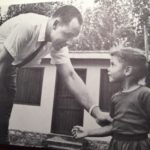Ethiopia’s First Peace Corps Staff, Part Four
After establishing the Peace Corps Headquarters on a eucalyptus-covered hillside above Addis Ababa, Wofford concluded that in a nation twice the size of Texas, the program should be administered on a regional basis. With Canby assigned to the former Italian colony of Eritrea, two other Associate Representatives (APCDs) were posted to the rest of Ethiopia although both were assigned houses in Addis Ababa.
William White was given primary responsibility for Volunteers in the north and west country which included the capitals of Gondar and Axum and the vast canyon of the Blue Nile.
William Kruse was assigned to the south and east, the land of the Rift Valley, the Ogaden desert and the cities of Harar and Diredawa.
Although he was born and raised in Cleveland, Bill White enrolled in Atlanta’s Morehouse College for one semester, this at the insistence of an aunt in Alabama “who wanted me to experience what the South is like for a Negro.”
He went back home—to Ohio State—for the rest of his college. His draft board gave him a deferment so that he could graduate in 1952 with a B.S. in social administration.
Disqualified for air cadets because he married the former Margaret Ann Childers of Cleveland, White was still eligible for the draft. He filled in as a taxi driver until May, 1953, when he was inducted into the Medical Corps and sent to Alaska on loan to the Air Force as a psychiatric social worker in an Anchorage hospital. In April, 1955, he was honorably discharged a corporal and given an airplane ticket back to Cleveland, where he attended law school for three semesters and worked nights in a post office “until I decided that none of tis was my cup of tea.”
With no rigidly formulated future plans, he oved his family to Los Angeles where he became executive secretary of the local United Nations Association. One year later, he became a neighborhood worker for the Los Angles County Commission on Human Relations and acquired the feeling that for the first time he was where he belonged.
I was supposed to do what I could do to ease tensions aroused by the racial integration of new neighborhoods. We would work with neighborhood groups, try to organize a local human relations commission, give courses in human relations with films and general discussion. I like to think we prevented what might have been a number of outright conflicts.”
After almost four years of this, White became an investigator for the southern California division of the State Fair Employment Practices Commission where he worked with the movie industry in an effort to prevent discriminatory hiring practices.
Spurred by a development interest in newly independent Africa, White wrote Lee St. Lawrence to ask about foreign air work. St. Lawrence was then traveling and when he was finally able to reply, he told White that he was now with the Peace Corps. This led to White’s reporting for the talent search interviews and finally to a telephone call from the White House. “Peggy almost dropped the phone on the floor. It was Harris Wofford, asking if I could be interested in Ethiopia.”
White arrived in Addis Ababa on May 6, on the same flight with Edward Corboy, who had come to take over as Associate Representative for Management.
Part Four, Ethiopia Staff
Research Document: Who’s Who in the Peace Corps Overseas Administration (1963)
The photographs are by Rowland Scherman, Paul Conklin and Jim Walls, first photographers for the agency.


No comments yet.
Add your comment